
Alishan High-Mountain Oolong is not merely a tea; it is a liquid map of Taiwan’s central mountain range, a cultural passport stamped by centuries of migration, ingenuity, and reverence for mist. International drinkers often meet it first through the floral perfume that escapes a still-warm gaiwan—notes of orchid, white peach, and a whisper of fresh cream that seem impossible to coax from a single leaf. Yet those aromatics are the distilled story of elevation, cultivar, and craft. To understand Alishan Oolong is to follow the road that climbs from Chiayi City at 30 m above sea level to the tea gardens that sit between 1,000 m and 1,400 m, where the Tropic of Cancer coolly brushes the peaks and clouds park themselves inside the forest for half the day.
History and Terroir
Tea bushes arrived in Taiwan during the 18th century with Fujianese settlers who carried Qingxin (literally “green heart”) cuttings across the strait. The cultivar, also known as TTES #12, found its spiritual home centuries later on Alishan only after the completion of the Alishan Forest Railway in 1912 opened the high ridges to commercial agriculture. At these altitudes ultraviolet intensity increases 15 % for every 300 m gained, prompting the plant to produce more amino acids and aromatic volatiles as natural sunscreen. The result is a leaf that is physiically tougher yet chemically more delicate, packed with L-theanine and floral esters. Night-time temperatures can drop 10 °C below daytime highs, slowing respiration and locking sweetness into the tender buds. Meanwhile, perpetual cloud cover functions like a giant silk diffuser, softening sunlight and lengthening the growing season so that a spring flush may be picked eight weeks later than low-elevation gardens. The cumulative effect is a concentration of flavor that cannot be replicated in valley plots or greenhouse simulations.
Garden Ecology
Walk through an Alishan tea farm at dawn and you step into a polyculture designed by subtropical climate rather than human blueprint. Giant bamboo, cedar, and Taiwan cherry rise above the tea hedges, their roots trading minerals with the camellia sinensis rhizosphere. Spider webs beaded with mountain dew glisten between rows, testimony to pesticide abstinence; farmers here prefer the insurance provided by biodiversity. Grasses are cut, not uprooted, to prevent erosion on 35-degree slopes, and every January the pruned branches are laid back as moisture-retaining mulch. Such practices pre-date modern organic certification, having evolved from the Indigenous Tsou people’s slash-and-burn rotations that respected watershed boundaries. Today many gardens carry Taiwan’s “Green Conservation” label, a program that links premium payments to documented wildlife sightings—Formosan rock macaques, Swinhoe’s pheasants, and even the rare alpine cicada whose song harmonizes with the click of shears during harvest.
Plucking Standard
The golden rule on Alishan is “one bud, three leaves, noon deadline.” Pickers start at first light when dew still guards the leaf from bruising, and they must finish before the sun reaches its zenith; after that, transpiration accelerates and the fragile compounds begin to oxidize prematurely. Baskets are woven from young bamboo strips precisely 45 cm in diameter—wide enough to keep the pickings cool, narrow enough to discourage compression. A skilled worker can harvest 5 kg of fresh leaf in four hours, the exact quantity needed to produce 1 kg of finished tea. Leaves are then weighed on site with portable digital scales powered by pocket-sized solar panels, ensuring that each batch enters the processing shed within two hours of plucking, a logistical choreography that preserves cellular integrity.
Crafting the Leaf: The Eight Stages
- Solar Withering: Leaves are spread 3 cm thick on hexagonal bamboo trays and left under filtered morning sun for 20 minutes. The goal is not desiccation but a gentle shock that initiates enzymatic activity.
- Indoor Withering: Trays move onto tiered racks inside a climate-controlled room kept at 22 °C and 65 % humidity. Over six hours workers fluff the leaves every 45 minutes, coaxing water out of the petiole without collapsing the cell walls.
- Bruising: The signature “yaoqing” step begins after midnight. Forty kilograms of leaf are tumbled inside a bamboo cylinder lined with horse-hair cloth; the drum rotates 18 times, then pauses for 3 minutes while the aroma is sniffed. This on-off cycle lasts two hours, creating